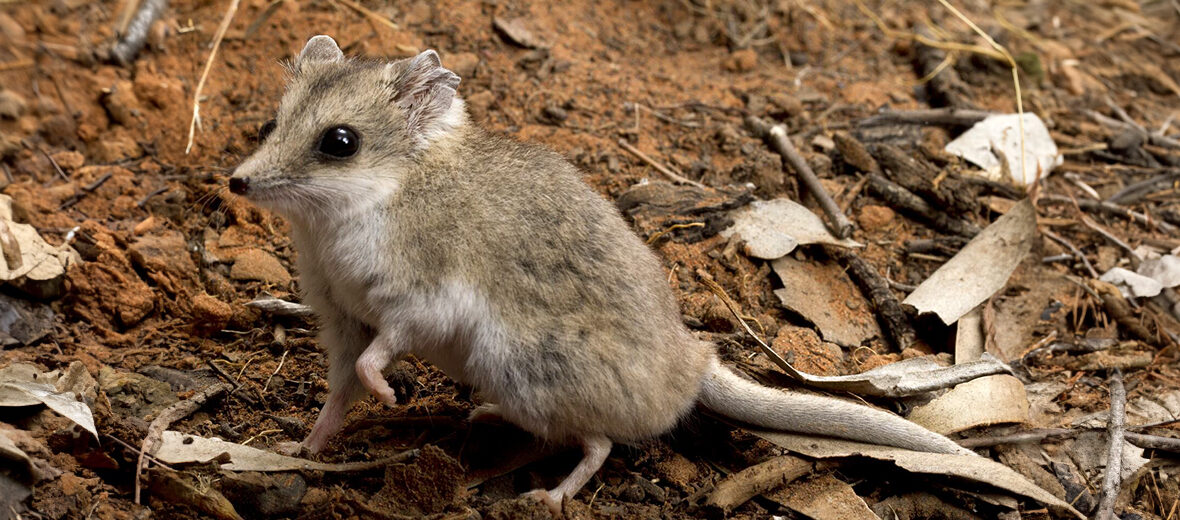
The fat-tailed dunnart is yet another mouse-like marsupial that is in the same family (Dasyuridae) as the quoll, Tasmanian devil, and little red kaluta. These, like so many other marsupials, dwell throughout much of Australia. With no major threats facing these little critters, the fat-tailed dunnarts are listed as Least Concern by the IUCN. Their population trend is stable.
First the Stats…
Scientific name: Sminthopsis crassicaudata
Weight: Up to .71 ounce
Length: Up to 3.54 inches, plus up to a 2.76 inch tail
Lifespan: Up to 18 months
Now on to the Facts!
1.) They get their namesake due to the fact that their tail becomes fat about an inch from the proximal end up to the tip.
2.) These critters have trichromat vision (3 independent color channels), which is similar to that of many other marsupials as well as many primates.
3.) Fat-tailed dunnarts tolerate a range of habitats like grassy woodlands, samphire shrublands (flowering plants in the amaranth family), desert environments, sparse grasslands, open shrublands, and farmlands where there is a fair amount of bare land.
4.) Intensive agriculture however has caused a decline in fat-tailed dunnart populations.
5.) Breeding season lasts from July – February.
But wait, there’s more on the fat-tailed dunnart!
6.) Females undergo up to a 13 day gestation that yields up to 10 joeys.
7.) The joeys remain in the marsupium (pouch) for up to 70 days.
Did you know…?
Joeys are born measuring smaller than a grain of rice and possess no bones.
8.) There is unfortunately up to a 33% mortality rate for joeys.
9.) The female will often have up to 2 litters in a year.
10.) Beetles, spiders, small reptiles, and amphibians are all on the menu.
But wait, there’s still more on the fat-tailed dunnart!
11.) Fat reserves are stored in their carrot-shaped tail and utilized during leaner times. Hence their fat tails.
12.) Invasive foxes, cats, dogs, and also native dingoes all prey on these little critters.
Did you know…?
While in torpor (a state of deep rest), their body temperature can drop as low as 58.28ºF.
13.) Fat-tailed dunnarts are nocturnal (active at night).
14.) Each night they consume up to their entire body weight in food!
15.) They slip into a daily state of torpor to preserve energy. Torpor is obtained when temperatures drop and/or when food is scarce.
But wait, there’s still a little more on the fat-tailed dunnart!
16.) Females are even able to enter into torpor while feeding without affecting her young.
17.) After coming our of a torpid state, these critters actively look for areas where they can bask in the sun to aid in the process of thermoregulating (adjusting their body’s temperature) to warm their core temperature.
Did you know…?
These marsupials utilize specialized, sharp teeth to grind their prey into fine pieces. This enhances their ability to obtain nutrients from their prey.
18.) They also engage in a behavior known as nesting. This is where a dunnart will share nest spaces with rodents, like the house mouse. Which is odd due to the fact that in times of abundant food availability dunnarts will prey on house mice.
19.) In August 2022, the University of Melbourne partnered with Texas-based biotechnology company Colossal Biosciences to attempt to re-create the thylacine utilizing the fat-tailed dunnart, 1 of its closest surviving relatives. Then return the “cloned” thylacine to Tasmania.
20.) The thylacine (Thylacinus cynocephalus), aka Tasmanian tiger or Tasmanian wolf, is a presumed extinct carnivorous marsupial that was native to the Australian mainland as well as the islands of Tasmania and New Guinea.
Now a Short Fat-Tailed Dunnart Video!
Be sure to share & comment below! Also, check out the Critter Science YouTube channel. Videos added regularly!
Want to suggest a critter for me to write about? Let me know here.
Some source material acquired from: Wikipedia & IUCN
Photo credit: David Paul – Museums Victoria



